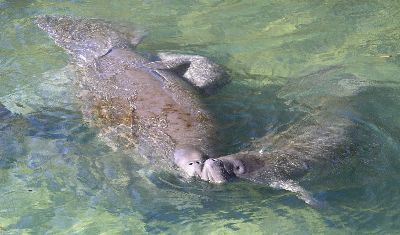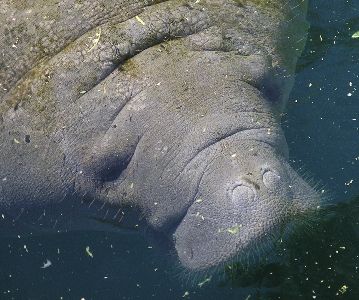February, 2007
Manatees
by Valerie
Anyone who has spent much time around Florida waterways has probably seen manatees. They are aquatic cows: huge, docile, social vegetarians that enjoy basking in the sun on cold days. While they seem slow, the power in those enormous tails is amazing, and they can put out a burst of speed that belies their bulk. But they rarely do that, and mostly they are seen slowly swimming along channels, or resting in groups in the warm springs.
Manatees belong to the order Sirenia. This is the only group of completely vegetarian aquatic mammals. Diversity is low, with just three species of manatees and the dugong. The famous Stellar sea cow was the largest member of the order, but it was hunted to extinction a mere 25 years after it was discovered. Although manatees swim in both salt and fresh water, they drink the latter. I've heard that some residents who live along Florida's numerous coastal canals will run a hose into the salty water to attract manatees, much like some people use peanuts to draw squirrels or bread for birds.

Wild manatees courting, Homosassa River, FL |
The manatee is endangered in Florida, and so it seems all the more surprising that they are so easy to see. There are specific places where they are known to gather, such as Blue Spring, where a state park protects them from harassment, and Crystal River where a power plant outflow provides a warm water haven. But I've also seen them just swimming along under a bridge while we were crabbing or heard them snorting when they come up for air in a nearby river. My first chance to see a manatee close up was at the University of Florida in Gainesville. Our family was camping in a nearby park and we heard that there was an orphaned manatee being cared for at the university. Even though I was quite young, I still remember how odd it seemed that an indoor swimming pool was harboring a rotund little mammal. When we were allowed to offer it a head of cabbage, the whiskery face felt like a rough brush, with the thickest bristles I'd ever felt on an animal. It's a sad fact that, if you don't happen to see a manatee swimming free in the wild, you can easily view one at a number of rehabilitation facilities for injured or orphaned manatees; their only enemy is the motorboat. Most adult manatees bear scars from encounters with propellers and many do not survive. There are simply too many fast-moving boats that want to use the same waterways the manatees do. Considering that manatees peacefully share the same habitat as large alligators, it makes for an ominous comparison in deadliness.

Captive manatee, Homosassa Springs, FL |
| 
Underwater, Homosassa Springs, FL |
|
While wild encounters with manatees are a treat, it is also fun to get a different perspective by seeing them in captivity. It is illegal to bother manatees in the wild, so swimming close to them is not usually an option. Aquariums make it possible, though, to see them underwater, and two places are especially noteworthy. Homosassa Springs State Wildlife Park serves as a rehab facility for injured female manatees. At any given time, they usually have at least a half dozen living in the large spring, which is fenced off from the nearby river. Not only do the manatees feed very close to a viewing platform and bask in the clear water along the banks of the spring run, but there is also an underwater structure in which people can look out into the spring while remaining dry behind large windows. It's sort of a reverse aquarium. The Lowry Park Zoo in Tampa keeps manatees as well. They have a big tank for them and the viewing is excellent.

Manatee aquarium, Lowry Park Zoo, FL |
Florida's burgeoning population of recreational motorboat users makes it seem unlikely that the manatee population will survive long-term. But for the time being, the animals are still numerous enough that an opportunity to see 50+ at a time, as I once saw in Blue Spring on a cold February morning, remains for those who want to witness a true wildlife spectacle.


